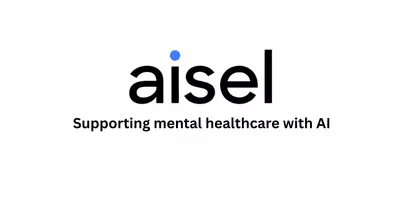
14 Oct 2025 ● Harmonia Careers
In the Spotlight: Q&A with Wellbeing and Culture Consultant, Clare E Kenny

In our latest edition of the In the Spotlight series, we speak with Clare E Kenny — a wellbeing and culture consultant whose career has been shaped by lived experience. After years in high-pressure corporate environments, Clare faced burnout, grief, anxiety, and later an ADHD diagnosis. Today, she channels those experiences into helping organisations build psychologically safe, inclusive workplaces where people can truly thrive.
In this in-depth conversation, Clare shares her personal journey, insights on invisible mental health struggles, and practical ways leaders and colleagues can build cultures of empathy, trust, and wellbeing.
From Burnout to Purpose: Clare’s Journey into Wellbeing and Culture
Can you tell us a bit about your background, particularly how your own experience with burnout, anxiety, and ADHD has shaped your work in wellbeing and culture?

I studied psychology at university, then spent the first half of my career in learning and development and leadership consultancies. I was client facing, running projects in high-pressure environments. For years I worked very long hours, often 16-hour days, always pushing for the next level. At the time I thought that was normal: work hard, play hard, recover just enough, and do it all again. Looking back, I can see I was constantly on the edge of burnout.
While I was in Singapore setting up the APAC arm of a business, my mum passed away suddenly. We were very close. As cliché as it sounds, it made me stop and ask what I was doing all this for. I realised I was living in a way that was not sustainable. I was exhausted, stressed, and not present in my own life. I left my job, travelled, and later, after my daughter was born in 2020, decided to carve out a career focused on creating workplaces where people can thrive rather than simply survive.
Since then I have worked both in house and as a consultant. At Burberry I designed and delivered the global wellbeing strategy, including policies on menopause, pregnancy loss, and bereavement, as well as programmes to build leadership capability and wellbeing champions. Now I partner with organisations to help them create cultures where people can perform at their best without sacrificing their health.
My personal experiences shape everything I do. I know first hand what it feels like to burn out and to live with anxiety, and I understand how workplace systems can contribute to that. More recently I was diagnosed with ADHD, a discovery that was both affirming and eye opening. It has strengthened my advocacy for neuroinclusive workplaces where different ways of thinking and working are recognised and valued. I do not just bring theory. I bring empathy, perspective, and practical insight into how leaders can build cultures where everyone has the chance to thrive.
Recognising Hidden Struggles at Work
In your experience, what are some of the most subtle or invisible signs that a colleague, or someone you manage, may be struggling with their mental health?
I am cautious about providing a checklist of signs because they can be misleading. A behaviour that suggests one person is struggling might mean something completely different for someone else. Rather than trying to spot invisible signs from the outside, I encourage leaders and colleagues to build environments where it is safe to talk openly.
That means creating regular opportunities for honest check ins, not just about workloads and deadlines but about how people are doing. Mental health is a spectrum. All of us have days when we feel on top of the world and days when we feel low. If leaders role model speaking openly about their own experiences across that spectrum, it becomes safer for others to do the same.
When those practices are part of the culture, you do not have to guess or interpret behaviours. People are far more likely to tell you when they are struggling, and to do so earlier, before it becomes something bigger.

The Cost of Missing the Signs
Why is it essential for managers and peers to be attuned to these subtle signs? What can happen if we miss them?
When we miss opportunities to connect, people often carry their struggles silently until they reach breaking point. Because stigma still exists, many delay seeking help until they are in crisis. By then the impact can be significant, not just for the individual but for the team and the organisation.
It is better to build a preventative culture where small concerns can be voiced early. Think of it like physical health. If you feel a sore throat coming on, you rest and take care before it worsens. With mental health, small adjustments and early conversations can make the same difference and may prevent someone from sliding into burnout or more serious difficulty.
When people know they can share openly without judgement, you also get the best from them. They can perform, innovate, and connect more effectively. Being attuned is not only about preventing problems. It is also about unlocking potential.

Leading with Empathy and Vulnerability
From a manager’s perspective, what are some meaningful, empathetic ways to reach out and offer support without overstepping boundaries?
Build regular, thoughtful check ins. Instead of the generic “How are you?”, try prompts such as “What is one thing getting in the way of you being at your best this week?” or “If your mood was a colour, what would it be today?” Creative questions invite genuine responses and help us avoid the autopilot of “How are you?” “Yeah, fine. You?”
Questions alone are not enough. The real power is in role modelling. When managers are honest about their own challenges, whether that is admitting a week has been stressful or sharing that something has been difficult, it shows the team it is safe to be human. Vulnerability from leaders builds trust and sets the tone for the whole culture.
If you are worried about someone, approach them gently. You might say, “I know these conversations can be difficult, but I want you to know I am here if you would ever like to talk.” That offers support without pressure. People are not always ready straight away, but consistency and care create the conditions for them to come forward when they are.
Making Invisible Struggles Visible
What everyday workplace practices or small cultural shifts can help make invisible struggles more visible, and make it more acceptable and safer for people to ask for help?
I believe storytelling is one of the most powerful tools when it comes to shifting culture. When people, especially leaders, share lived experiences, whether about mental health, grief, menopause or any other life challenges, it signals that these topics are not taboo. When I was at Burberry, we launched a menopause policy alongside a video from a senior leader who shared her personal journey. That story did more to normalise the subject than any policy document could.
Small, everyday practices matter. Build wellbeing check ins into meetings, encourage leaders to role model vulnerability, and spotlight colleagues who share openly. Once one person speaks up, it often creates a ripple effect. I have found that whenever I share my own experiences, whether about ADHD, addiction or grief, the response is often “oh wow, me too”. Those moments of shared humanity break down stigma and create space for others to ask for help.
Supporting Colleagues with Compassion
How can colleagues at a peer level offer help if they notice someone may be struggling? What gentle approaches work best?

People do not need all the answers, they just need to show they care. Sometimes that looks like inviting someone for a coffee and giving them space to talk about whatever they like. Other times it is simply saying, “I am here if you need me.”
Role modelling helps here too. By sharing small personal challenges, you make it safer for others to open up. It does not have to be big. Saying “I have had a tough week, I am exhausted from my daughter not sleeping well” shows that it is okay to talk about being human.
Resist the urge to jump in with fixes. It is natural to want to make someone feel better, but phrases like “It is not that bad” or “Why do you not just…” can feel dismissive. What people often need most is to feel heard and validated. Ask open questions such as “That sounds really tough. Can you tell me a bit more about how it feels for you?” and then listen. That validation is often more healing than any solution.
If appropriate, you can gently signpost to resources such as an Employee Assistance Programme or health benefits. The foundation, though, is empathy and space to be heard.
Reducing Stigma and Normalising Mental Health Conversations
Given the stigma often associated with mental health, especially hidden conditions, what strategies can people use to normalise conversation and reduce shame?
You do not need to be an expert. Often the best response is the simplest: “Thank you for telling me that, it sounds really tough! Can you share a bit more about how it is affecting you?” That communicates curiosity, openness, and safety without judgement.
Normalisation comes from weaving mental health into everyday conversation, not saving it for moments of crisis. Talk about the full spectrum, from days when you feel great, to the “meh” days, to the more difficult days. If leaders and colleagues are open about all of it, mental health becomes something we all experience, rather than something that divides people into “well” and “unwell”.
The more we role model this and create space for others to do the same, the more shame and stigma lose their hold. It becomes part of the fabric of the workplace rather than a hidden or awkward subject.
Tools and Frameworks for Empathetic Leadership
Are there any specific resources, phrases, or frameworks you recommend for managers or colleagues to use in these conversations?

There are some excellent resources I recommend. Brené Brown’s short video on empathy is brilliant for understanding how to listen without trying to fix immediately. I also point leaders to frameworks on trust and psychological safety, which offer practical ways to create environments where people feel safe to speak up.
A few simple phrases go a long way:
• “Thank you for sharing that with me.”
• “That sounds really tough. Can you tell me more about how it is affecting you?”
• “I am here if you would like to talk, no pressure.”I have written about trust, psychological safety, and leading with vulnerability in my own blogs, which provide step by step guidance for managers looking to build these skills. Sometimes having a few go to phrases and frameworks is the difference between shying away from a difficult conversation and leaning into it with confidence.
Building Psychologically Safe and Inclusive Cultures
What kind of organisational or leadership level approaches create more inclusive, psychologically safe environments?
Psychological safety is about more than being nice. It is about creating an environment where people feel safe to be themselves, share diverse perspectives, and challenge the status quo without fear of judgement. That requires intentional action at both organisational and leadership level.
At an organisational level, build structures that invite diverse voices, such as asking “What have we missed?” or “What could we do better?” in regular meetings. Structures alone are not enough. The cultural test is how leaders respond when someone does speak up. If leaders react defensively or dismiss concerns, people will stop sharing.
Leaders who admit mistakes, demonstrate vulnerability, and respond constructively to challenge send a powerful signal that honesty is welcome. Creating psychologically safe environments also means recognising and valuing different needs, whether that is flexibility, neuro-inclusion, or wellbeing support. It is about building a culture where difference is a strength and where people know their voice genuinely matters.
One Simple Step to Start Creating a Healthier Workplace
What is one simple action you would advise any manager or team member to take tomorrow to start offering more meaningful support to someone facing invisible mental health challenges?
Start with yourself. Take a moment to reflect on how you are really doing, then share a little of that honestly with your team or a colleague. It does not have to be a big disclosure. Something as simple as “I have been feeling a bit overwhelmed this week” can be enough.
That small act of vulnerability signals to others that it is safe to do the same. When we normalise talking about our own mental health across the spectrum, from the great days to the difficult ones, we create the conditions for others to share too. It is a simple, powerful first step towards a more supportive culture.
Closing Thoughts
Clare’s insights remind us that creating a mentally healthy, inclusive culture isn’t about grand gestures — it’s about small, consistent acts of humanity. By leading with empathy, normalising honest conversations, and embracing vulnerability, organisations can move beyond burnout to build environments where people genuinely thrive.
A heartfelt thank you to Clare E Kenny for sharing her story and leadership insights with us. Her work continues to inspire meaningful, lasting change in how we think about wellbeing and culture at work.

About Clare
With a global career spanning strategic consulting, leadership development, and workplace wellbeing, Clare has worked with organisations such as Channel 4, Specsavers and Harry Potter Studios to strengthen performance by transforming culture. She has a strong focus on identifying the root causes of poor wellbeing and underperformance - and helping leaders build healthier, more human workplaces where people and businesses can truly thrive.
Her commitment to this work is also deeply personal. Having experienced burnout, anxiety, addiction, and late-diagnosed ADHD, she understands first-hand the impact that workplace culture can have on our mental health and sense of self. It’s this combination of lived experience and professional insight that shapes everything she does.


